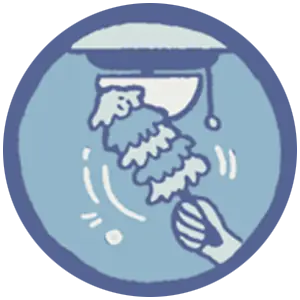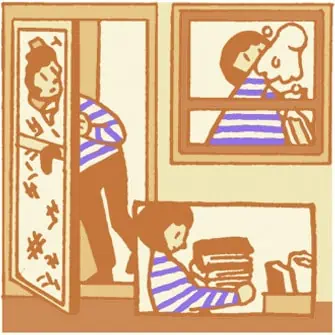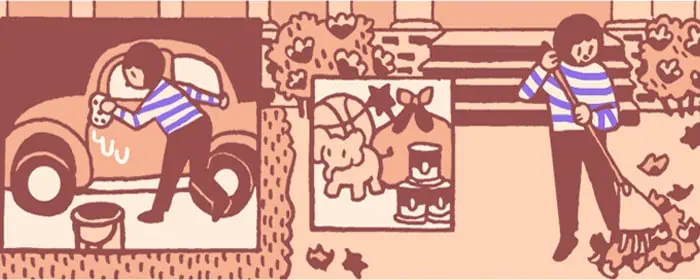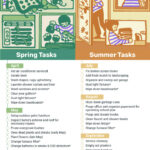Every year you aim to start good habits with your health, your career, your relationships. But what about your home? The space you spend time in every.single.day should receive some TLC and attention, too.
Instead of vowing to get your body in shape, let’s get your home in shape! In 2018, you may have neglected your home and we’re not judging. (I mean, who really knows the last time they changed their air filter?)
Your 2022 Home Checklist
We’ve curated a handy-dandy checklist to map out the year ahead. If you accomplish each task every month, your home is going to be a well-oiled machine. Now let’s get to it!
Note: Tasks marked with * are recurring tasks you’ll complete multiple times over the course of the year.
Winter Tasks

While there will always be recurring tasks to complete on the checklist, the winter time is all about purging and organizing every nook and cranny in your home.
Split it up over the next 3 months and it won’t be quite as overwhelming!
January
- Purge file cabinet of unnecessary paper
- Set up a system in a filing cabinet for this year’s important paperwork
- Purge and donate clothing
- Dust light fixtures*
- Wipe down baseboards*
February
- Compile tax documents; set up a time to complete taxes
- Purge and donate kitchen gadgets
- Purge and donate pantry foods
- Wipe down fridge*
- Clean garbage disposal*
- Change furnace filter*
March
- Purge and organize toiletries
- Purge and organize the linen closet
- Check caulking around bathtubs and showers
- Clean car inside and out*
Spring Tasks
No duh: the springtime is all about spring cleaning! You spent the past few months purging and organizing spaces in your home, but now it’s time to give everything a nice deep clean. (And don’t forget to clean these 6 overlooked areas.)
Not to mention, the springtime is the start of all your big outdoor projects. Get your lawn and garden cleaned, manicured, and ready for new life to grow. These are especially crucial because you really can’t do anything about it once you miss your window!
April
- Get air conditioner serviced
- Aerate lawn
- Wash drapes, rugs, upholstery
- Launder shower curtain and liner
- Wash windows and screens*
- Clear your gutters*
- Dust light fixtures*
- Wipe down baseboards*
May
- Setup outdoor patio furniture
- Inspect home’s exterior and roof for necessary repairs
- Prune overgrown bushes
- Clear dead plants and shrubs (early May)
- Plant flowers (late May)
- Change furnace filter*
- Change batteries in smoke & CO2 detectors*
June
- Replace outdoor lights that have burned out
- Clean grill and check propane tank
- Clean deck and make necessary repairs
- Power wash sidewalks and walkways
- Clean car inside and out*
Summer Tasks
Oh, the sweet summertime. It can be easy to let your household chores slide during the summer months. We get it, summer is about vacations and relaxing. But these are worthwhile tasks to accomplish when the temps are warmer and you’re spending more time outside (hopefully).
Also, as you near Labor Day, school will be on the mind. That’s when you’ll want to make sure your home is still organized from your hard work earlier this year. Purge paper clutter and books so you can start the school year fresh!
July
- Fix broken screen doors
- Add fresh mulch to landscaping
- Organize and sweep out the garage
- Dust light fixtures*
- Wipe down baseboards*
August
- Hose down garbage cans
- Purge office and organize paperwork for the upcoming school year
- Purge and donate books
- Clean faucet and shower heads
- Wipe down fridge*
- Change furnace filter*
September
- Service chimney
- Empty out planters
- Store lawn furniture
- Clean car inside and out*
- Wash windows and screens*
Fall Tasks
Keep that momentum going into the fall season! Fall is the time to prepare for the cold months ahead. Focus on prepping the exterior of your home to protect it against the snow and ice that will soon be here.
With the holidays approaching, this is also a time when you’re the most likely to host guests. Luckily, your home should be running smoothly with all of the work you’ve put in this year. We also encourage you to keep December a little light on the home projects, since you will most likely have limited free time.
October
- Plant spring-blooming plants, shrubs, tall grasses, etc.
- Remove hoses from water spickets
- Fertilize lawn
- Check your sump pump
- Clear your gutters*
- Dust light fixtures*
- Wipe down baseboards*
November
- Check weatherstripping on doors and windows
- Have heating systems serviced
- Rake and gather leaves
- Purge pantry and donate (good timing for the holidays!)
- Change furnace filter*
- Change batteries in smoke & CO2 detectors*
December
- Purge toys and books (good timing for the holidays!)
- Purge and donate extra holiday decorations
- Clean car inside and out*
Free Printable – Home Checklist
If you’re ready to make 2022 the best year yet for your home, then we encourage you to download or screenshot this free printable. That way, you can print it out and check things off as you go. (Trust us, there is no better feeling than checking off those little boxes!)




